The African violet (Saintpaulia ionantha) is a popular houseplant that grows and flowers under light conditions typically found in the home or under artificial light. Many different varieties, types, and flower colors exist (Figure 1).
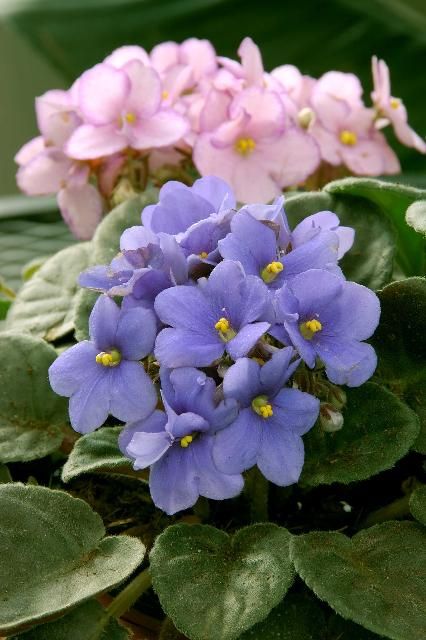
Credit: akit/iStock/Thinkstock, © akit
Light Intensity
For best growth and flowering, African violets require bright light (~1000 foot candles), but no direct sunlight (Figure 2). This is the amount of light within 3 feet of a southeast- or west-facing window. Lower light levels for longer periods of time are also adequate. The appearance of a plant will indicate whether light levels are too high, too low, or just right. If light is too low, leaves are usually thin and deep green, and appear to reach up for light. The plants may grow but will flower poorly or not at all. In such instances, supplemental artificial light will help promote flowering.
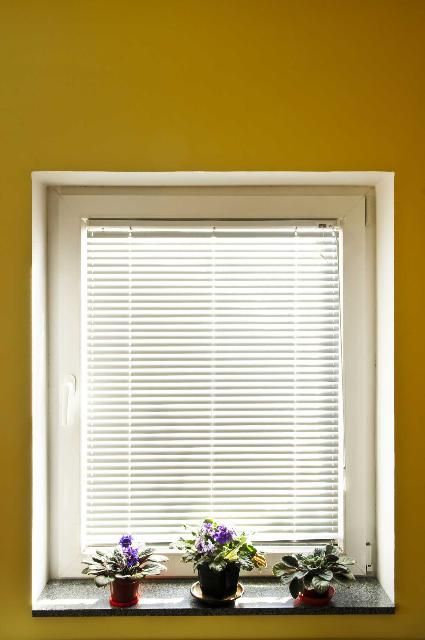
Credit: Elena Elisseeva/iStock/Thinkstock, © Elena Elisseeva
Excessive light causes leaves to be pale or greenish-yellow. Some leaves may show dark green areas where they have been shaded by upper leaves. Growth slows when light is too high and plants become very compact. Flowering will also begin to decrease.
Light Duration
Growth and flowering of African violets is also affected by duration of exposure to light and darkness. To bloom, they need 8 to 12 hours (up to 16 hours) of light and 8 hours of darkness per day. A plant that gets the right level of light, but for too short a period, will do poorly compared to a plant given weak light for a long period.
Artificial Light
Where natural light is unavailable or reduced, African violets can be grown under artificial light. Incandescent light may be used, but fluorescent lamps give better results, are less expensive to operate, and produce less heat. Plants grown entirely under fluorescent light should receive approximately 600 foot-candles of light for about 16 hours per day. This amount of light can be provided by suspending two 40-watt fluorescent tubes 12 to 15 inches above plants. Tubes should be mounted in suitable fixtures equipped with reflectors. Commercial lighting systems, often referred to as "grow lights," are also available. Current options include HID (high intensity discharge), compact fluorescent and T5 bulbs, as well as LED (light-emitting diode) technology. Some of these approaches offer energy savings and promote better plant growth than fluorescent bulbs alone.
Temperature and Humidity
African violets prefer a night temperature of 65–70°F, but will grow satisfactorily at 60 to 80°F. Under prolonged high temperatures, growth and flowering is reduced. During hot weather, place plants in the coolest place in the home or in an air-conditioned room.
African violets grow best in high humidity, which can be achieved by setting pots in water-tight metal or plastic trays filled with pebbles and water. Avoid placing pots directly in water to prevent root rot.
Soil and Pots
Drainage is one of the most important considerations in choosing or preparing a soil mixture for African violets. Excellent plants can be grown in mixtures consisting of equal parts of peat moss, vermiculite, and perlite. Pre-packaged African violet soil mixes are also available. Soil mixtures should have a pH of about 6.0 to 6.5 (slightly acid) for best results. Pots must have drainage holes. Old clay or plastic pots can be reused if you wash them thoroughly with soap and water or a dilute bleach solution.
Watering
Water that is satisfactory for human consumption can be used on African violets. They should not be watered routinely because their water needs vary with soil mixture, drainage, light, temperature, and humidity. Plants in clay pots require more frequent watering than those in plastic pots since evaporation is greater. In general, water African violets whenever the soil surface feels dry to the touch, but before it becomes hard or the plant wilts.
African violets may be watered from the top or bottom. When watering from the top, apply enough water to thoroughly saturate the soil and discard excess water that drains through the bottom of the pot. Make sure the temperature of the water is the same or slightly warmer than that of the room. If cold water touches relatively warm leaves, it will cause yellowish spots or streaks on the upper leaf surfaces.
Watering from the bottom may be done by placing the pot in a container to which about one inch of water is added. When the soil surface becomes moist, remove the pot, allow it to drain, and pour out the excess water. Self-watering pots can be purchased, or you can easily construct one. Create a "water wick" (Figure 3) from a braided nylon stocking or any other acrylic, nylon, or synthetic material. Pre-soak the wick in water to saturate it and insert it into one of the drainage holes of a pot. Make a water reservoir from a lidded plastic container. Cut two holes in the lid—one for the wick and the other for adding water. Set the pot on the lid and feed the wick through one of the holes, making sure it is long enough to reach the bottom. Fill the reservoir using the remaining hole. Plants should occasionally be watered from the top to flush accumulated fertilizer salts from the soil.
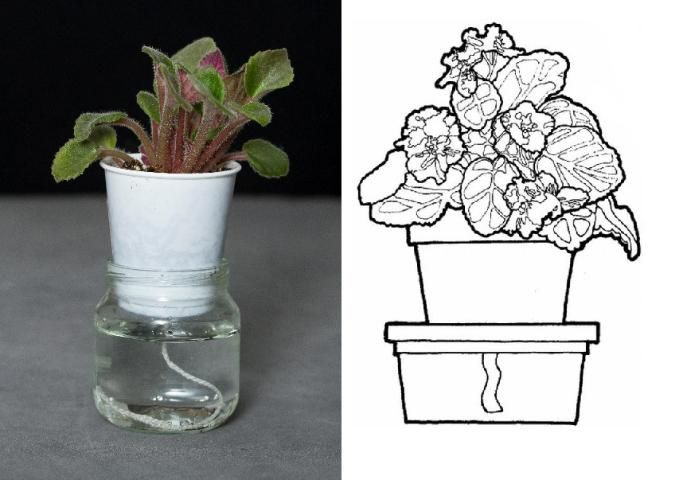
Credit: UF/IFAS
Fertilizer
Water-soluble fertilizers such as 20-20-20 or 15-30-15 are commonly sold for use on African violets. Mix the fertilizer in water at one-fourth the recommended rate and apply it each time you water. Soil should be moist before dissolved fertilizer is applied. Discard excess water and fertilizer solution that drains from the bottom.
A gradual loss in leaf color combined with reduced growth and flowering usually indicates that the plant needs nutrients. If in doubt, fertilize one or two plants and wait ten days to see if you see a reaction. If plant growth is evident and the leaves become darker in color, fertilize the rest of the plants. Over-fertilized, African violets develop tight centers, and the new leaves take on a rusty appearance.
Propagation
African violets are propagated easily by leaf cuttings (Figure 4). Select a healthy and firm leaf from the middle of the plant and snap or cut it off leaving the petiole (leaf stem) intact. Trim the petiole to about 1–1 ½ inches in length. A combination of half vermiculite/ half sand, or half vermiculite/half potting mix makes an ideal propagation medium. Insert the petiole into the medium by pushing it into a hole made with a pencil or similar tool. Roots normally form at the petiole base in three to four weeks and leaves of new plants appear three to four weeks after roots form. Plants will begin flowering six to nine months later.
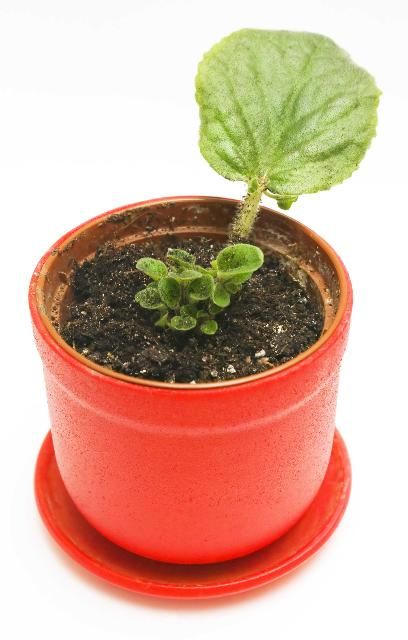
Credit: Irina Soloshenko/iStock/Thinkstock, © Irina Soloshenko
Plants with multiple crowns can be propagated by division. Carefully divide the crowns so that each portion has some roots. Then pot each division separately.
Old plants often develop an elongated stem that gives them a "leggy"' appearance. These can be successfully re-rooted by cutting the plant off at the soil level and inserting the stem into a suitable potting mixture. Leggy plants can also be repotted; plant them so that the leafless stem is below the soil line, where it can grow new roots.
Pest Management
Most insects and mites can be managed with insecticidal soap but leaf and flower damage may occur. Test the product on a leaf or two before spraying the entire plant. Mealy bugs (Figure 5) may be controlled by mixing alcohol with an equal amount of water and touching each insect with a cotton swab dipped in the solution. Their cottony egg masses should also be removed in this way. Cyclamen mites cause severe stunting of plants and are very difficult to control. Unfortunately, the best management strategy for this pest is to discard affected plants.
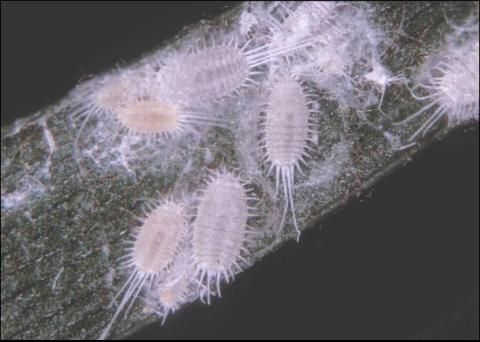
Credit: James Castner, UF/IFAS
Root diseases are usually caused by over-watering. The first sign of this problem is usually a limp, unthrifty plant. In most cases the plant should be discarded.
Petiole rot occurs when petioles touch the edge of the pot and develop brown, sunken areas at points of contact. This injury is caused by fertilizer salts that accumulate on the rims of clay pots. Petiole rot can be avoided by waxing the pot rim or covering it with aluminum foil.
Various diseases can affect African violets, but adequate spacing, use of sterilized soil, and prompt removal of faded flowers and unhealthy leaves will help prevent disease problems.
Contact your local UF/IFAS Extension office for help in diagnosing and managing insect and disease problems: https://sfyl.ifas.ufl.edu/find-your-local-office/.
Reference
African Violet Society of America, Inc. http://www.avsa.org/